
The Uffizi Gallery is a prominent art museum located adjacent to the Piazza della Signoria in the Historic Centre of Florence in the region of Tuscany, Italy. One of the most important Italian museums and the most visited, it is also one of the largest and best-known in the world and holds a collection of priceless works, particularly from the period of the Italian Renaissance.

Filippino Lippi was an Italian painter working in Florence, Italy during the later years of the Early Renaissance and first few years of the High Renaissance.

Pietro Perugino, an Italian Renaissance painter of the Umbrian school, developed some of the qualities that found classic expression in the High Renaissance. Raphael became his most famous pupil.

The Galleria dell'Accademia di Firenze, or "Gallery of the Academy of Florence", is an art museum in Florence, Italy. It is best known as the home of Michelangelo's sculpture David. It also has other sculptures by Michelangelo and a large collection of paintings by Florentine artists, mostly from the period 1300–1600. It is smaller and more specialized than the Uffizi, the main art museum in Florence. It adjoins the Accademia di Belle Arti or academy of fine arts of Florence, but despite the name has no other connection with it.

Santo Stefano degli Ungheresi was the church of the Hungarians in Rome. Located next to the Vatican, the old church was pulled down in 1778, to make room for an extension of St. Peter's Basilica.
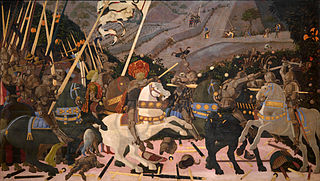
The Battle of San Romano is a set of three paintings by the Florentine painter Paolo Uccello depicting events that took place at the Battle of San Romano between Florentine and Sienese forces in 1432. They are significant as revealing the development of linear perspective in early Italian Renaissance painting, and are unusual as a major secular commission. The paintings are in egg tempera on wooden panels, each over 3 metres long. According to the National Gallery, the panels were commissioned by a member of the Bartolini Salimbeni family in Florence sometime between 1435 and 1460. The paintings were much admired in the 15th century; Lorenzo de' Medici so coveted them that he purchased one and had the remaining two forcibly removed to the Palazzo Medici. They are now divided between three collections, the National Gallery, London, the Galleria degli Uffizi, Florence, and the Musée du Louvre, Paris.

The Vasari Corridor is an elevated enclosed passageway in Florence, central Italy, connecting the Palazzo Vecchio with the Palazzo Pitti. Beginning on the south side of the Palazzo Vecchio, it joins the Uffizi Gallery and leaves on its south side, crossing the Lungarno dei Archibusieri, then following the north bank of the River Arno until it crosses the river at Ponte Vecchio. At the time of construction, the corridor had to be built around the Torre dei Mannelli, using brackets, because the tower's owners refused to alter it. The corridor conceals part of the façade of the Church of Santa Felicità. It then snakes its way over rows of houses in the Oltrarno district, becoming narrower, to finally join the Palazzo Pitti. The corridor's full length is approximately one kilometre.
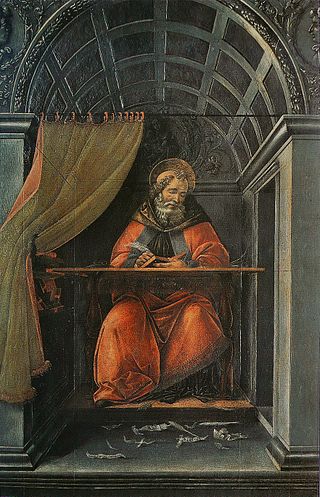
Saint Augustine in His Study, is a painting by the Italian Renaissance master Sandro Botticelli, finished around 1490–1494. It is housed in the Uffizi, in Florence.
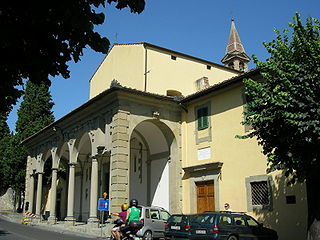
The Convent of San Domenico is a Dominican convent in Fiesole, Italy, situated between the hill of Fiesole and the suburbs of Florence. It was founded in 1406 and completed in 1435 on the initiative of Giovanni Dominici and the bishop of Fiesole, Jacopo Altoviti, both of them friars at the Basilica of Santa Maria Novella in Florence.

The Coronation of the Virgin is a painting by the Italian early Renaissance master Fra Angelico, executed around 1434–1435 in Fiesole (Florence). It is now in the Musée du Louvre of Paris, France. The artist executed another Coronation of the Virgin, now in the Uffizi in Florence.
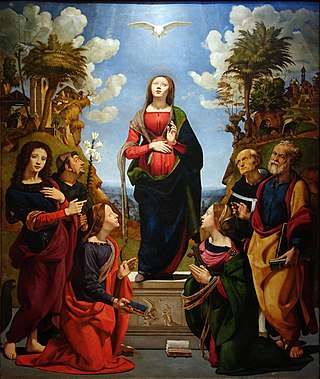
The Immaculate Conception with Saints is a painting by the Italian Renaissance painter Piero di Cosimo, executed between 1485 and 1505. It is housed in the Uffizi Gallery of Florence, Italy.

The via dei Georgofili bombing was a terrorist attack carried out by the Sicilian Mafia in the very early morning on 27 May 1993 outside the Uffizi in Florence, Italy.
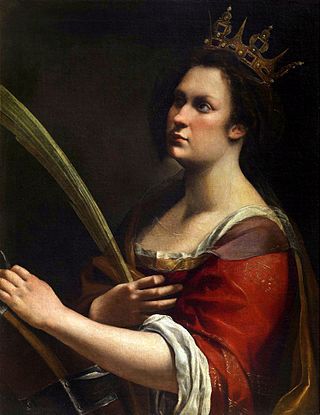
Saint Catherine of Alexandra is a painting by the Italian Baroque artist Artemisia Gentileschi. It is in the collection of the Uffizi, Florence. Gentileschi likely used the same cartoon or preparatory drawing to create both this painting and the Self-Portrait as Saint Catherine of Alexandria (1615–1617), now in the National Gallery, London.

Holy Family with St Jerome and St Anne is a 1534 signed and dated oil-on-canvas painting by Italian artist Lorenzo Lotto, first recorded at the Palazzo Pitti at the start of the 18th century and now in the Uffizi in Florence.

Madonna and Child with the Holy Trinity and Two Saints is a painting by Luca Signorelli, from 1510, now in the Uffizi in Florence. It is a sacra conversazione, with the Madonna enthroned between Michael and Gabriel, with Augustine (left) and Athanasius (right) below and the Holy Trinity above.

The Novitiate Altarpiece or Madonna and Child with Saints is a c.1440-1445 tempera on panel painting by Filippo Lippi, now in the Uffizi in Florence. A sacra conversazione, it originally had a predella painted by Pesellino centred on a Nativity. The main panel shows Cosmas and Damian either side of the Madonna and Child, whilst Francis of Assisi is shown at far left and Anthony of Padua at far right. On an architectural frieze above the figures are the Medici's heraldic balls.

Annunciation is an oil-on-canvas painting, now in the Uffizi in Florence. It and The Martyrdom of Saint Justina were bought in Venice by Paolo del Sera, intermediary and agent for cardinal Leopoldo de' Medici in 1654.

Holy Family with Saint Catherine and Saint John the Baptist is an oil-on-canvas painting by Paolo Veronese, now in the Uffizi in Florence. Its dating is debated, varying between his early period and his late one, the latter influenced by Tintoretto, with the latter the majority view, placing it in c.1562–1565. Some early copies survive, one on parchment by Carlo Loth, one by Gian Antonio Guardi and a third of almost exactly the same dimensions as the original, possibly autograph.

Nativity of Saint John the Baptist is a 1526 oil on panel desco da parto painting by Pontormo, now in the Uffizi, where it has been since at least 1704. There is a copy in the Fogg Art Museum. Its status as an autograph work is accepted by most art critics, but was disputed by Philippe Costamagna.

Mystic Marriage of Saint Catherine is an oil-on-canvas painting executed c. 1528 by the Italian Renaissance painter Domenico Beccafumi. It is now in the Palazzo Chigi-Saracini in Siena.




















